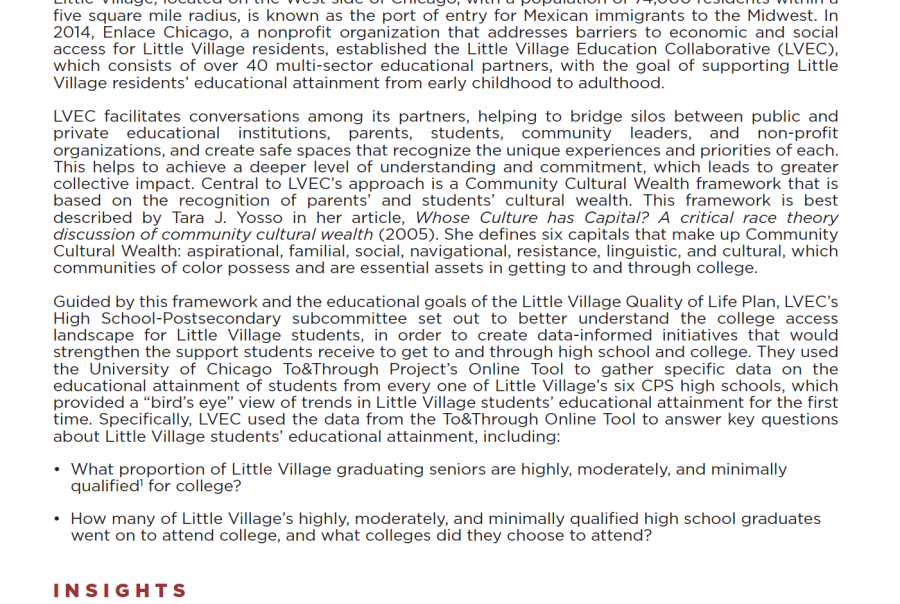Background
Little Village, located on the West side of Chicago, with a population of 74,000 residents within a five square mile radius, is known as the port of entry for Mexican immigrants to the Midwest. In 2014, Enlace Chicago, a nonprofit organization that addresses barriers to economic and social access for Little Village residents, established the Little Village Education Collaborative (LVEC), which consists of over 40 multi-sector educational partners, with the goal of supporting Little Village residents’ educational attainment from early childhood to adulthood.
LVEC facilitates conversations among its partners, helping to bridge silos between public and private educational institutions, parents, students, community leaders, and non-profit organizations, and create safe spaces that recognize the unique experiences and priorities of each. This helps to achieve a deeper level of understanding and commitment, which leads to greater collective impact. Central to LVEC’s approach is a Community Cultural Wealth framework that is based on the recognition of parents’ and students’ cultural wealth. This framework is best described by Tara J. Yosso in her article, Whose Culture has Capital? A critical race theory discussion of community cultural wealth (2005). She defines six capitals that make up Community Cultural Wealth: aspirational, familial, social, navigational, resistance, linguistic, and cultural, which communities of color possess and are essential assets in getting to and through college.
Guided by this framework and the educational goals of the Little Village Quality of Life Plan, LVEC’s High School-Postsecondary subcommittee set out to better understand the college access landscape for Little Village students, in order to create data-informed initiatives that would strengthen the support students receive to get to and through high school and college. They used the University of Chicago To&Through Project’s Online Tool to gather specific data on the educational attainment of students from every one of Little Village’s six CPS high schools, which provided a “bird’s eye” view of trends in Little Village students’ educational attainment for the first time. Specifically, LVEC used the data from the To&Through Online Tool to answer key questions about Little Village students’ educational attainment, including:
- What proportion of Little Village graduating seniors are highly, moderately, and minimally qualified for college?
- How many of Little Village's highly, moderately, and minimally qualified high school graduates went on to attend college, and what colleges did they choose to attend?
Insights
The final report, “Little Village College Enrollment Report: Where Data Calls for Social Change,” used To&Through Project data to reveal some key trends and opportunities:
- Graduation rates for Little Village CPS High Schools have steadily increased, from 60 percent in 2011 to 79 percent in 2015; however, college enrollment rates have remained fairly stagnant, fluctuating from 41 percent to 47 percent.
- The percentage of Little Village students enrolling in 2-year community colleges has increased while overall college enrollment rates have stayed the same, meaning that more Little Village high school graduates are enrolling in 2-year community colleges versus 4-year colleges and universities.
- The percentage of highly, moderately, and minimally qualified Little Village students stayed around the same from 2012 to 2015, with 30 percent of highly qualified students and 58 percent of moderately qualified students consistently not enrolling in college—showing that many students who are academically fit for college aren't going.
To better understand the forces and factors driving these trends, LVEC conducted a series of student interviews and parent focus groups, which illuminated many of the challenges Little Village students have faced in accessing and persisting through college, including financial and information constraints — either a lack of a trusted source of information or lack of access to consistent and comprehensive information. The key insights from these focus groups can be found in the report accessible on Enlace’s LVEC webpage, www.enlacechicago.org/lvec.
Recommended Strategies
Enlace Chicago’s report on Little Village students’ educational attainment suggests approaches to translating these insights to concrete actions through collaboration, system alignment, and research. Through access to data and the creation of the Little Village College Enrollment Report, LVEC has been able to leverage initiatives with key personnel in the Chicago Public Schools (CPS) district and at public postsecondary institutions in Chicago to support Little Village students’ access to and success in college. These initiatives include:
Alignment between the CPS District and Nonprofit Community:
Coordination between the CPS district and non-profit organizations working directly with students in Little Village high schools, in terms of working toward the same goals and supporting target student populations in complimentary ways.
Little Village Education Agendas:
Tailored plans from each of the top public postsecondary institutions that Little Village students attend with specific initiatives and supports designed to ensure Little Village students’ smooth transition from high school to college and college graduation.
Additional research:
Exploring the college access experiences of undocumented students, who are currently excluded in the quantitative data on CPS high schools.
Ultimately, the report shows that many Little Village students do want to go to college and are academically fit for college, and that parents do want to support students towards college. However, various external barriers have impeded students’ transition from high school to college. Access to data through the To&Through Project has allowed Enlace Chicago to create a narrative on college access for Little Village students that includes the unique assets and challenges of the community and its members.

